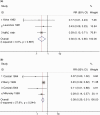Folic acid to reduce neonatal mortality from neural tube disorders
- PMID: 20348114
- PMCID: PMC2845867
- DOI: 10.1093/ije/dyq028
Folic acid to reduce neonatal mortality from neural tube disorders
Abstract
Background: Neural tube defects (NTDs) remain an important, preventable cause of mortality and morbidity. High-income countries have reported large reductions in NTDs associated with folic acid supplementation or fortification. The burden of NTDs in low-income countries and the effectiveness of folic acid fortification/supplementation are unclear.
Objective: To review the evidence for, and estimate the effect of, folic acid fortification/supplementation on neonatal mortality due to NTDs, especially in low-income countries.
Methods: We conducted systematic reviews, abstracted data meeting inclusion criteria and evaluated evidence quality using adapted Grading of Recommendations, Assessment, Development and Evaluation (GRADE) methodology. Where appropriate, meta-analyses were performed.
Results: Meta-analysis of three randomized controlled trials (RCTs) of folic acid supplementation for women with a previous pregnancy with NTD indicates a 70% [95% confidence interval (CI): 35-86] reduction in recurrence (secondary prevention). For NTD primary prevention through folic acid supplementation, combining one RCT with three cohort studies which adjusted for confounding, suggested a reduction of 62% (95% CI: 49-71). A meta-analysis of eight population-based observational studies examining folic acid food fortification gave an estimated reduction in NTD incidence of 46% (95% CI: 37-54). In low-income countries an estimated 29% of neonatal deaths related to visible congenital abnormalities are attributed to NTD. Assuming that fortification reduces the incidence of NTDs, but does not alter severity or case-fatality rates, we estimate that folic acid fortification could prevent 13% of neonatal deaths currently attributed to congenital abnormalities in low-income countries.
Discussion: Scale-up of periconceptional supplementation programmes is challenging. Our final effect estimate was therefore based on folic acid fortification data. If folic acid food fortification achieved 100% population coverage the number of NTDs in low-income countries could be approximately halved.
Conclusion: The evidence supports both folic acid supplementation and fortification as effective in reducing neonatal mortality from NTDs.
Figures




References
-
- Kulkarni A, Ehrenkranz RA, Bhandari V. Effect of introduction of synchronized nasal intermittent positive-pressure ventilation in a neonatal intensive care unit on bronchopulmonary dysplasia and growth in preterm infants. Am J Perinatol. 2006;23:233–40. - PubMed
-
- Jegatheesan P, Keller RL, Hawgood S. Early variable-flow nasal continuous positive airway pressure in infants < or =1000 grams at birth. J Perinatol. 2006;26:189–96. - PubMed
-
- The Global Burden of Disease. 2004. [(13 September 2009, date last accessed)]. update. 2004. http://www.who.int/healthinfo/global_burden_disease/GBD_report_2004updat....
-
- McIntosh N, Helms PJ, Smyth RL, editors. Forfar & Arneil's Textbook of Pediatrics. 6th. Churchill Livingstone: Edinburgh; 2003. pp. 902–907.
-
- Wyszynski DF, editor. Neural Tube Defects: from Origin to Treatment. US: Oxford University Press; 2006. pp. 250–71.
Publication types
MeSH terms
Substances
LinkOut - more resources
Full Text Sources
Medical

